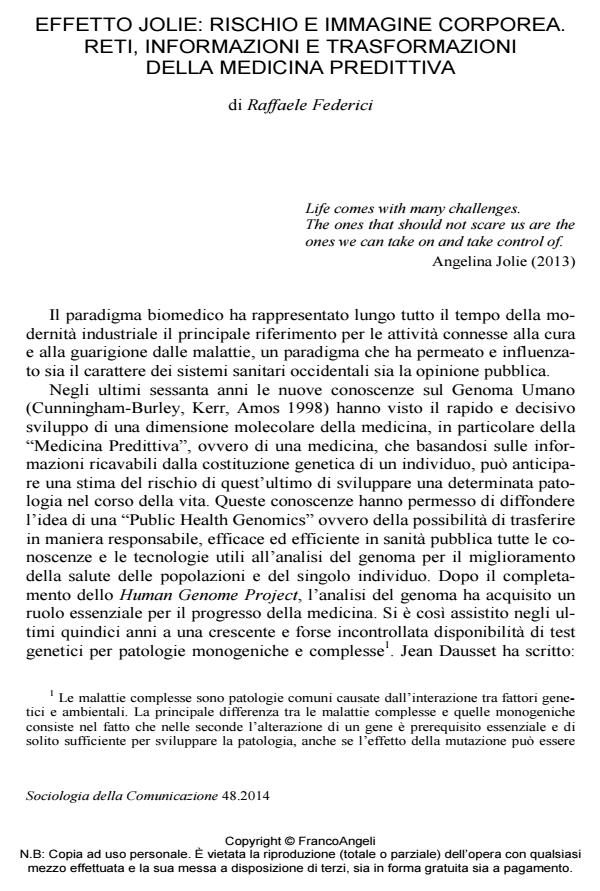The Jolie effect: risk and body image. Networks, information and transformations of predictive medicine
Journal title SOCIOLOGIA DELLA COMUNICAZIONE
Author/s Raffaele Federici
Publishing Year 2014 Issue 2014/48 Language Italian
Pages 8 P. 68-75 File size 128 KB
DOI 10.3280/SC2014-048007
DOI is like a bar code for intellectual property: to have more infomation
click here
Below, you can see the article first page
If you want to buy this article in PDF format, you can do it, following the instructions to buy download credits

FrancoAngeli is member of Publishers International Linking Association, Inc (PILA), a not-for-profit association which run the CrossRef service enabling links to and from online scholarly content.
The author aims to look at the issue of a new "communication frontier" created by the possibility of having the entire sequence of the human genome. This "frontier" represents a complex communicative context in which the relationship between social actor, media, scientific research and medical risks to become a real battleground between power and languages. Any communication of health implies the need to inform effectively the public and decision-makers who are not necessarily experts, even more generally "non-experts", with a non-trivial language that simplifies the "expert knowledge" in a world characterized oriented toward a complex hyper-specializations .
Keywords: Public Health Genomics, information, expert knowledge, predictive medicine, organization.
- Baggio G., Basili S., Lenzi A. (2014), Medicina di genere. Una nuova sfida per il medico, «Quaderni delle conferenze permanenti delle Facoltà di Medicina e Chirurgia», n. 62, pp. 2277-2284.
- Conrad P., Gabe J. (1999), Introduction: Sociological perspectives on the new genetics: an overview, «Sociology of Health & Illness», vol. 21, n. 5, pp. 505-516.
- Cunningham-Burley S., Kerr A., Amos A. (1998), The Social and Cultural Impact
- on the New Genetics, final reports to the ESRC. Dausset J. (2001), Editorial, «Journal of Medicine and Biotechnology», vol. 1, pp. 1-3.
- Federici R., Garzi R. (2011), Il farmaco come se la persone contasse. Farmaci, farmacie e anziani, Morlacchi, Perugia.
- Giarelli G. (2005), Medicine non convenzionali e pluralismo sanitario, FrancoAngeli, Milano.
- Henderson L., Kitzinger J. (1999), The human drama of genetics: ‘hard’ and ‘soft’ media representations of inherited breast cancer, «Sociology of Health & Illness », vol. 21, n. 5, pp. 1-19.
- Hurley R. (2013), Angelina Jolie’s double mastectomy and the question of who owns our genes, «BMJ», 346:f 3340.
- Jolie A. (2013), My Medical Choice, «New York Times», May 14.
- Kluger J., Park A. (2013), The Angelina effect, «Time», vol. 181, n. 20, May 27, pp. 30-33.
- Mazzoli G. (1999), Il rapporto ricercatore, medico, paziente fra informazione, comunicazione e relazione, «Annali Istituto Superiore Sanità», vol. 35, n. 2, pp. 301-305.
- Michel A. (2014), Beautiful Disease: The Story of Angelina Jolie’s Mastectomy in the American Media, Marquette University e-Publications@Marquette, Fall 2013.
- Rapp R. (2014), Foreword, in S. Gibbon, G. Joseph, J. Mozersky, A. Nieden, S. Palfner (eds.), Breast cancer gene. Research and medical practice. Transnational perspectives in the time of BRCA, Routlegde, New York.
- Sassatelli R. (1999), Plasticità, corpo e potere. Una rassegna della “politica del corpo” come problematica sociologica, «Rassegna Italiana di Sociologia», 4, ottobre-dicembre, pp. 650.
- Saywell C., Henderson L., Beattie L. (1999), Sexualised illness: the newsworthy body in media representations of breast cancer, in L. Potts (ed.), Ideologies of Breast Cancer, Macmillan, London.
- Shwartz D. A., Martin W. J. (2006), Translating Translational Biomedicine for Environmental Health, «Environmental Health Perspect», April 114, 4.
- Watson J. D., Berry A. (2006), DNA. Il segreto della vita, Adelphi, Milano.
Raffaele Federici, Effetto Jolie: rischio e immagine corporea. Reti, informazioni e trasformazioni della medicina predittiva in "SOCIOLOGIA DELLA COMUNICAZIONE " 48/2014, pp 68-75, DOI: 10.3280/SC2014-048007